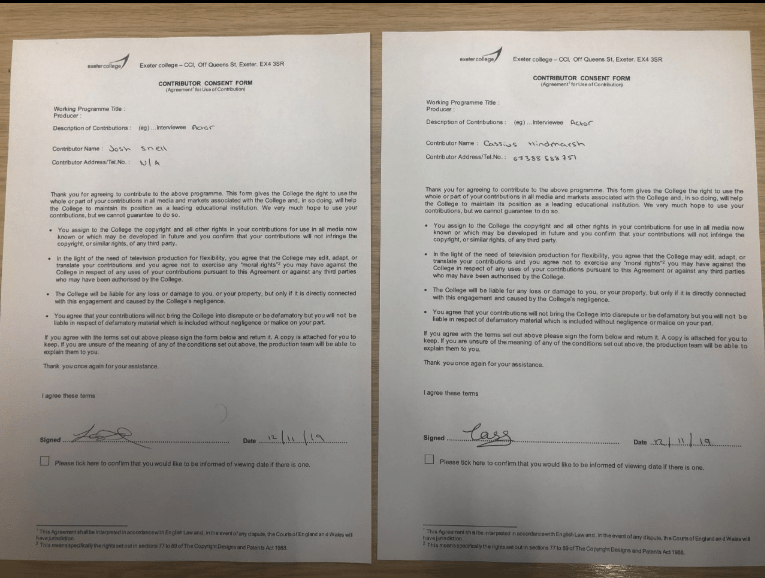Part One- Understanding Documentary:
Documentaries should be informative, interesting and in some cases, emotional.
A documentary is a type of film or TV programme that aims to present factual information to an audience. It should be completely unbiased however some fail to achieve this goal, for example; the Michael Jackson documentary (Leaving Neverland) seemed to be unfair as it didn’t express both sides of the story.
When making documentaries, there are different formats to follow depending on what the director wants. These are some of them:
- Realism- The reconstruction of an event, this could be based on a novel or a story.
- Dramatization- When the subject of the documentary is dramatized by the director in order for it to become more engaging for the viewer.
- Narrativization- Narrative is used in documentary’s to tell a story, directors often use narrative theory in order to engage audiences.
Documentary modes:-
https://en.wikipedia.org/wiki/Documentary_mode
Documentary mode is a conceptual scheme developed by documentary theorist, Bill Nichols, that seeks to distinguish particular traits and conventions of various documentary film styles.
Nichols identifies six different documentary ‘modes’ in his scheme: poetic, expository, observational, participatory, reflexive, and performative.
Expository-
http://sites.stedwards.edu/comm4399fa2013-jhender4/2013/10/03/expository-documentary-mode/
Expository documentary mode is the category in which most documentaries would fall into and is most familiar to us. It is frequently used in nature and TV documentaries.
The easiest way to recognize this mode is by determining voice. In expository documentary mode the narrator speaks directly to the viewer through voice-over to accompany or illustrate visuals, in which the audience usually does not see the speaker or narrator throughout the doc.
Expository documentaries primary aim is to educate their audience and explain their subject. This mode is famously seen in documentaries narrated by David Attenborough where they will ‘assume a logical argument’, informing the audience of what they are seeing on screen.
Examples:
- Frozen Planet
- March of the Penguins
- An Inconvenient Truth
Poetic-
With the poetic mode of documentary, the goal is not to create a film with a traditional narrative but rather to look into presenting patterns and associations to create meaning and evoke an emotional response from the audience. This is often achieved by arranging imagery into rhythms and juxtapositions. Unlike many documentaries, people that are a part of a poetic documentary are seen more like objects or “raw material” rather than characters with complex personalities and backstories.
The poetic mode “moves away from the ‘objective’ reality of a given situation. In other words, instead of using linear continuity to create a structure, it arranges its shots by means of associations, tone and rhythm. A subjective, abstract representation of reality is shown to the audience with emphasis on the visuals. Poetic documentaries are usually associated with avant-garde film-making.
Examples:
- The House Is Black
- Samsara
Observational-
The Observational mode, also referred to as cinema verite, direct cinema or fly-on-the-wall documentary is a more specific type of documentary telling. Fly on the wall often means that the footage is raw and shaky or jumpy. Nothing is staged and what you see is completely natural. There are of course arguments asking how natural someone can be when a camera is present, despite how non-intrusive it is. However this does not necessarily detract from the mode itself.
Observational documentaries were essentially born out of a movement in the 1960’s and 1970’s by a group of filmmakers who referred to themselves as ‘actuality filmmakers’. Due to the advance in technology during this time, sound and camera equipment became easier to use and manoeuvre, this then allowed filmmakers more freedom and the ability to observe events without being intrusive to their subjects.
Examples:
- Don’t Look Back
- Armadillo
- Benefits street
Participatory-
Participatory mode is often investigative film-making where a question is asked or a controversial topic is explored and the filmmaker is showing the audience the film-making process of their subject. The filmmaker can become an integral part of the film. This mode has become a popular form of documentary telling in the last 30 years or more with names such as Nick Broomfield and Louis Theroux championing this technique. The filmmaker does not influence the subject but will attempt to subjectively engage with their subject despite their personal beliefs.
Examples:
- Icarus
- Louis Theroux: The City Addicted to Crystal Meth
- Aileen Wuornos: The Selling of a Serial Killer
Reflexive-
Reflexive documentaries are often known as quite experimental and acknowledge the way a documentary is constructed and that it is impossible to show a purely objective and truthful subject due to how many processes there are. The reflexive mode will provoke audiences to “question the authenticity of documentary in general”. Mocumentaries can sometimes fall under the reflexive mode due to their self-awareness.
Examples:
- Exit Through The Gift Shop
- The Man With A Movie Camera
Performative-
The performative mode of documentary is the direct opposite of the observational mode. Performative documentaries will emphasize and encourage the filmmakers involvement with the subject. Performative documentaries tend to be more emotionally driven and may have a larger political or historical motivation.
Because the filmmaker tends to be passionately involved, performative documentaries will usually be subjective in one way or another. Unlike many modes of documentary, performative do not set out to reach a truth but show a perspective or ‘what is like to be there’.
Examples:
- Super Size Me
- Catfish
Documentary glossary:-
Accuracy-
https://www.bbc.co.uk/academy/en/articles/art20130702112133794
Accuracy means not only getting the facts right, such as names, places, dates of birth, quotes, but accurately reporting opinions expressed by those who you report.
Accuracy is often defined as a truthful reproduction of an event or activity of public interest. Documentaries should be 100% accurate with no false information.
An example of this is ‘Benefits Street’. Benefit street is a documentary that is based on people who are on benefits that live on a particular street in Birmingham. This doc has both accurate and inaccurate parts as because its an observational documentary, the audience can see what these people get up to on a daily basis so everything that is seen is accurate. However as the documentary especially shows people who are drug users, alcoholics and robbers, it doesn’t show the whole picture of what living on benefits is like. So to an audience, it sheds a bad light on the community of people that are on benefits.
Balance-
Balance is normally defined as a situation in which different elements are equal or in the correct proportions. In documentaries, it should always be balanced with correct arguments from both sides.
An example of unbalanced documentary is again ‘Benefits Street’. This is because the documentary follows only a few people which the majority of, break laws daily. It doesn’t show the people who are trying to find jobs, who are struggling massively and who are not committing crimes. This immediately makes the audience have a negative opinion on people who live on benefits, which makes this an unfair, unbalanced documentary.
Impartiality/Objectivity/Subjectivity-
- Impartiality is… An avoidance of bias, prejudice etc. ‘To remain impartial’
- Objectivity is… remaining truthful even outside of a subject’s individual bias and feelings
- Subjectivity is… how someone’s judgment is shaped by personal opinions and feelings instead of outside influences.
Benefit street is an example of a documentary that doesn’t follow these definitions. This is because the programme is slightly biased as it only shows what a couple of people are like on benefits which portrays a certain light on other people.
Opinion-
The definition of opinion is a view or judgement formed about something, not necessarily based on fact or knowledge. In documentaries, there can be opinions in it but it cannot be opinion based as then it may not be factually correct and can give the audience wrong information.
An example of this is ‘Leaving Neverland’. This documentary focuses on two men, Wade Robson and James Safechuck, who allege they were sexually abused as children by the singer Michael Jackson.
Representation-
Representation is how media texts deal with and present gender, age, ethnicity, national and regional identity, social issues and events to an audience. Media texts have the power to shape an audience’s knowledge and understanding about these important topics. This makes them very powerful in terms of influencing ideas and attitudes.
Contract with viewer-
Contract with Viewer is an unwritten law between the producers and the target audience. The rule basically states that the overall finished documentary will match the criteria of the one that they were initially informed about through TV advertisement or some other source.
Analyzing a documentary:-
Benefit Street-
Benefit street is a British documentary series that is broadcasted on Channel 4. The show is about documenting the lives of several residents that live on James Turner Street in Birmingham. Newspapers including The Daily Mail and The Guardian reported that 90% of the residents claim benefits. In the documentary, it shows the residents committing crimes, including shoplifting, public alcohol abuse and portrays a situation in which people have a lack of motivation and a dependency on welfare payments.
The mode of this documentary is observational which can also be referred to as a fly on the wall documentary. This means that the makers and camera men follow the subjects around but are not seen in the documentary, this can create a more realistic and shaky approach as they can capture some raw footage from following them around for many hours of the day that other modes couldn’t. I also feel that this documentary is slightly expository as there is a narrator who gives out information as a voice over. However, I feel like in Benefit Street, it is slightly dramatized for the entertainment of the viewers which can create a false perception on the residents.
Documentaries have to follow a certain amount of rules so that it does not have any false information in it, these are things such as accuracy, balance, representation and to remain impartial. Benefit Street was seen as controversial as it didn’t follow some of these rules and received hundreds of complaints. This was because it does seem slightly dramatized and is biased as it only shows the people that are on benefits who commit crimes and have no motivation and it doesn’t show the other percent of people on benefits who are trying to get jobs and succeed in their life. Complaints arose as people who were on benefits felt attacked.
Using secondary and primary research, I found that Benefit Street is featured on Channel 4 and their audience is mostly under 30’s. However this programme does attract a lot of different viewers such as young people as they find it interesting and binge worthy in some cases. There is also information suggesting that people who have lower incomes would be more interested in this show than people with higher incomes, this is because people who are working class can relate more and also enjoy watching these type of programmes more.
Part Two- Who watches documentary’s- Netflix research:
Secondary research:
History of streaming service-
https://media.netflix.com/en/about-
https://en.wikipedia.org/wiki/Netflix
Netflix is the world’s leading internet entertainment service with over 151 million paid memberships in over 190 countries enjoying TV series, documentaries and feature films across a wide variety of genres and languages. Members can watch as much as they want, anytime, anywhere, on any internet-connected screen. Members can play, pause and resume watching, all without commercials or commitments.
Netflix, Inc. is an American media-services provider and production company headquartered in Los Gatos, California. The company’s primary business is its subscription-based streaming service which offers online streaming of a library of films and television programs, including those produced in-house. Netflix’s initial business model included DVD sales and rental by mail, but Hastings abandoned the sales about a year after the company’s founding to focus on the initial DVD rental business.
Netflix timeline-
Netflix was founded in 1997 and is now the world’s biggest entertainment service. Here is a timeline to briefly show Netflix’s history:
- 1997– Reed Hastings and software executive Marc Randolph co-found Netflix to offer online movie rentals.
- 1998– Netflix launches the first DVD rental and sales site, netflix.com.
- 1999– Netflix creates a subscription service which offers DVD rentals for a low monthly price.
- 2000– Netflix introduces a personalized movie recommendation system, which uses Netflix members’ ratings to accurately predict choices for all Netflix members.
- 2002– Netflix makes its initial public offering (IPO on Nasdaq under the ticker “NFLX” with 600,000 members in the US.)
- 2005- The number of Netflix members rises to 4.2 million.
- 2007– Netflix introduces streaming, which allows members to instantly watch television shows and movies on their personal computers.
- 2008/9– Netflix partners with consumer electronics companies to stream on the Xbox 360, Blu-ray disc players and TV set-top boxes. Then in 2009, Netflix started to stream on the PS3, Internet connected TVs and other Internet connected devices.
- 2010– Netflix is available on the Apple iPad, iPhone and iPod Touch, the Nintendo Wii, and other Internet connected devices. Netflix launches its service in Canada.
- 2011– Netflix launches throughout Latin America and the Caribbean.
- 2012– Netflix became available in Europe including the United Kingdom, Ireland and in the Nordic Countries. Netflix wins its first Prime-time Emmy Engineering Award.
- 2013– Netflix expanded to the Netherlands. Netflix launched its first slate of original programming including House of Cards, Hemlock Grove, Arrested Development and Orange is the New Black.
- 2014– Netflix launched in 6 new countries in Europe (Austria, Belgium, France, Germany, Luxembourg and Switzerland). Netflix gains 31 Prime-time Emmy nominations including outstanding drama series, comedy series and documentary or nonfiction special for “House of Cards”, “Orange is the new black”, and “The Square” respectively. House of Cards won three Prime-time Emmy Awards. Netflix was the first internet TV network nominated for the Prime-time Emmy. Netflix now has over 50 million members globally.
- 2015– Netflix launches in Australia, New Zealand and Japan, with continued expansion across Europe in Italy, Spain and Portugal. The first Netflix original feature film “Beasts of No Nation” is released.
- 2016– Netflix is available worldwide. Netflix launches in 130 countries bringing their global entertainment service to 190 total countries around the world. Netflix premieres Stranger Things, which would go on to become an acclaimed and award-winning worldwide phenomenon.
- 2017– Netflix wins its first Oscar, with The White Helmets for Best Documentary Short Subject. Netflix hits 100 million members globally.
- 2018– Netflix wins Oscar for Best Documentary Feature for Icarus. Netflix announces overall deals with Ryan Murphy, Kenya Barris, Jason Bateman. Netflix’s “Summer of Love” brings back classic Rom-Coms including popular films “The Kissing Booth”, “Set it Up”, “Sierra Burgess is a Loser”, “Happily Ever After and one of Netflix’s most-watched movies of all time, “To All The Boys I’ve Loved Before”. Netflix becomes the the most nominated service at 2018 Prime-time and Creative Arts Emmy Awards with 112 nominations. Ties with HBO for most wins taking home 23 accolades for series include Godless, Seven Seconds, GLOW, and Queer Eye.
Netflix statistics-
https://www.statista.com/topics/842/netflix/
https://www.businessofapps.com/data/netflix-statistics/#1
Key statistics:
- As of 2019, there are 151.56 million paid subscribers worldwide and 60.1 million of them are from the US.
- 23 languages are currently supported by Netflix.
- 51% of US streaming subscriptions are to Netflix.
- 50% of US Netflix subscribers use it several times per week
- In 2017, Netflix subscribers streamed around one billion hours of content per week.
- January 1st is the biggest streaming day of the year.
- Netflix accounts for 8% of the total time people spend watching videos.
User statistics:
- Netflix viewership statistics by year- Netflix user growth in Q2 2018 fell below analysts’ expectations of 1.2 million in the US, and 5.1 internationally (again, this was higher than Netflix’s own estimation). In reality, the gains were 0.7 million US net adds, while 4.5 internationally.
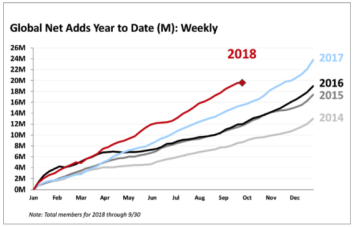
- Total Netflix subscribers, US v International- As of Q3 2018, Netflix users number 137.1 million in total. Of these, 57% of these users come from outside the US.
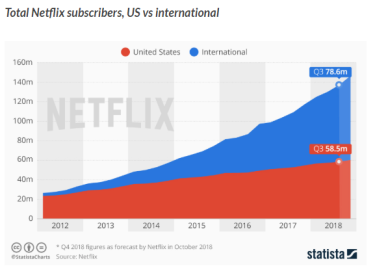
- US Netflix user numbers v other streaming services- The CNBC All-American Economic Survey 2018 found that 57% of Americans use a paid streaming service. Netflix dominates, with a market share of 51%, with Amazon Prime in second with 33% (2018).
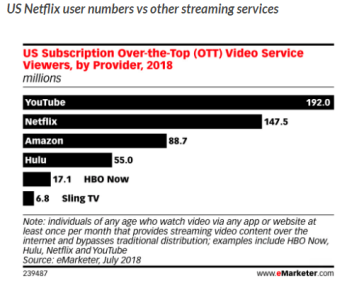
- UK Netflix v Amazon Prime user demographics- Amazon Prime users prefer to see established male Hollywood stars. Netflix subscribers, on the other hand, look to up and coming actors, and strike a far healthier gender balance in their top 10.
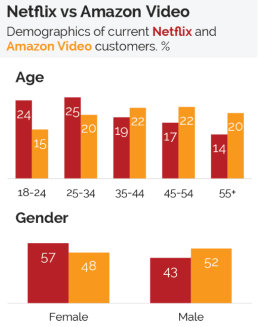
Netflix demographics:
I am using these statistics and graphs for my viewer profile but however here are the graphs-
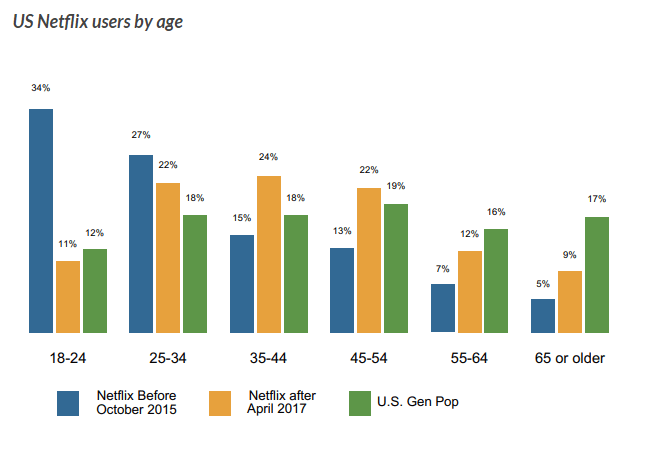
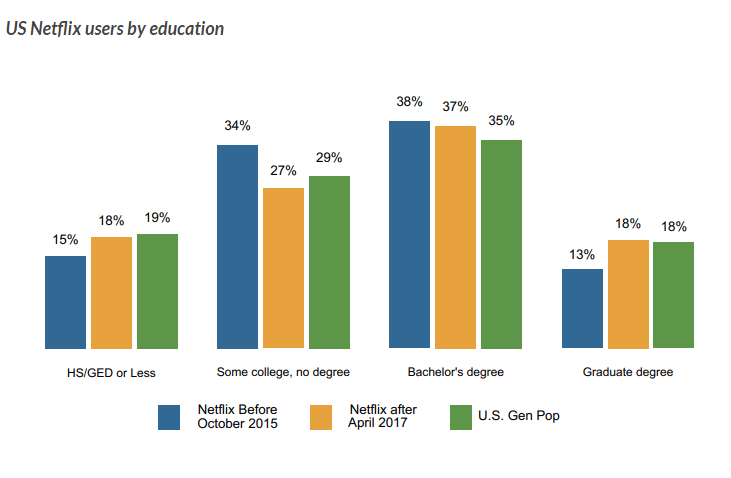
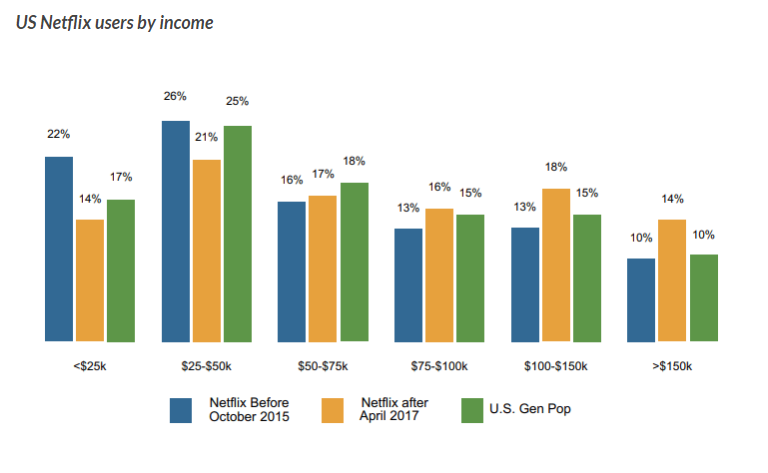
Usage statistics:
How often do subscribers watch Netflix- These figures refer to those who only use Netflix. Interestingly, those who subscribe to Netflix in conjunction with another service seem to use Netflix more often, with close to 60% logging in a few times per week.
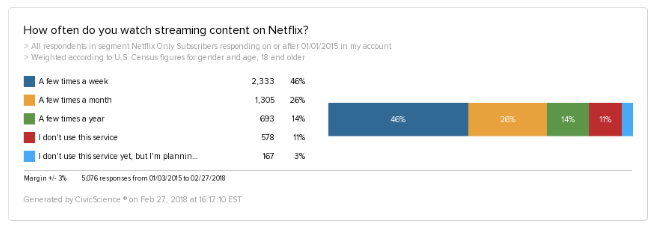
How often do subscribers to two streaming services watch Netflix- The trend continues for those with three subscriptions, with two-thirds watching multiple times a week. Perhaps the takeaway is that users with more subscriptions are more deeply engaged with streaming. And that those who are spending more money will be more inclined to make sure they’re getting their money’s worth.
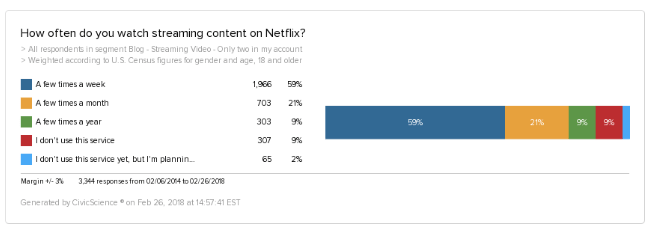
Netflix’s Documentaries-
Currently, there are 442 documentaries on Netflix. Netflix has created many successful and intriguing documentaries that have took over and been the main topic of conversation such as ‘Conversations with a Killer: The Ted Bundy Tapes’ and ‘The disappearance of Madeleine McCann’.
Here are a few examples:
- ‘Conversations with a killer: The Ted Bundy Tapes’– It is an American documentary that premiered on Netflix on January 24, 2019, the 30th anniversary of Bundy’s execution. Created and directed by Joe Berlinger, the four 60-minute episodes were sourced from over 100 hours of interviews and archival footage of serial killer Ted Bundy, as well as interviews with his family, friends, surviving victims, and the law enforcement members who worked on his case.
- ‘Cowspiracy’– It is a documentary, executive-produced by Leonardo DiCaprio, premiered globally on Netflix on September 15, 2015.
- ‘The Disappearance of Madeleine McCann’
- ‘Fyre’
- ‘Our Planet’
Audience profile:-
For my viewer profile, I am using US statistics as I am not able to find any websites with the UK statistics. I have already included information on some of Netflix’s statistics and target audience statistics in my secondary research however I decided to do a viewer profile on some of Netflix’s key demographics such as their viewers age, gender, income and geodemographics.
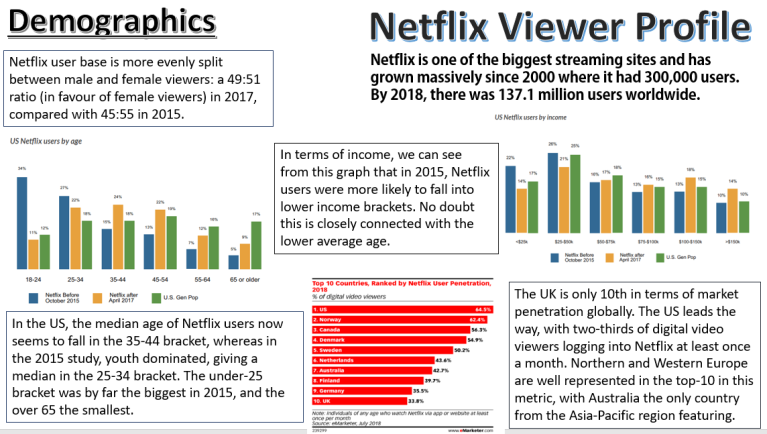
Primary research:
Vox Pops-
Asking the public-
Questions:
- Have you used Netflix before?
- Do you prefer using Netflix to other streaming platforms?
- Have you ever paid for a subscription?
- Do you enjoy watching documentaries?
- Do you think Netflix streams the best documentaries? if not, what platform would you choose if you wanted to watch a documentary?
Public answers:
- Debbie, 54- “Personally, I don’t use Netflix as it’s not something I need. I watch the Tele and have done for many years”
- Robyn, 19- “I watch Netflix every night as it’s cheap because i’m a student and it’s got everything I need on it. I do like watching documentaries but only on Netflix as they have the most interesting topics and they’re the most fun to watch”
- Chad, 23- “Netflix is something I use on a daily basis but I think the reason I and a lot of other people my age use it, is because it’s cheap for students and streams a lot of shows and documentaries that the younger generation are into, like serial killers”
- Duncan, 49- “I have heard of Netflix however watching I am quite happy watching my TV channels and maybe something on iPlayer if I missed it when it was on Tele.”
From these vox pop results, it shows that Netflix’s target audience is more towards the younger ages such as Robyn who was 19, in the age range of 15-24, which is their target audience.
Survey-
https://www.surveymonkey.co.uk/r/67Q2ST6
For part of my Netflix primary research, I decided to do a survey to figure out what Netflix’s overall target audience is and also to find out what Netflix’s audience is when it comes to documentaries.
For this survey, I created 10 suitable questions varying from personal questions such as age and gender to questions about how often they use Netflix etc.
After I finished my survey, I put the link on my Instagram bio for people to complete it. I had 15 people complete it. Once this was done, I looked at all the individual responses and decided to draw a table to figure out the data trends throughout my survey.
This is the table:
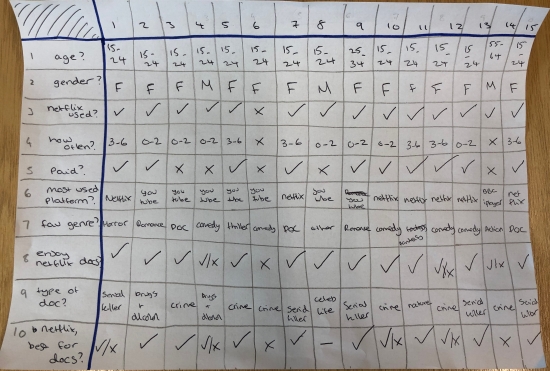
This showed all of the 15 responses in columns so I could clearly see what the majority audience are for Netflix and Netflix’s documentaries.
These are my answers from the individual questions in my survey:
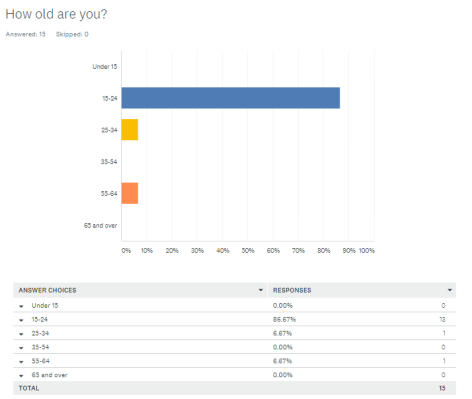
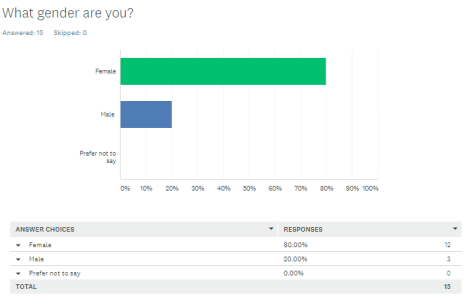
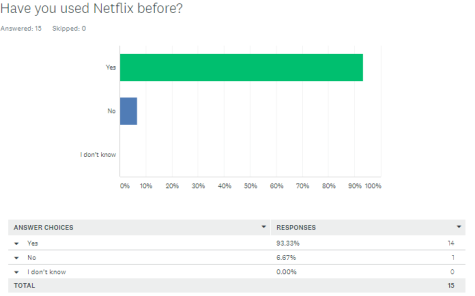
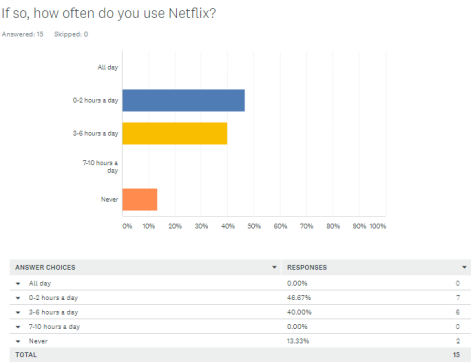
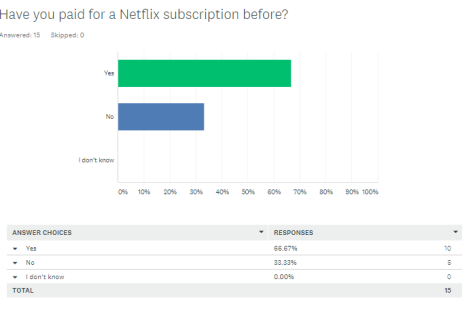
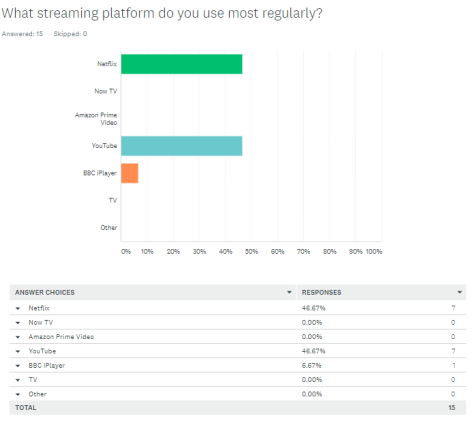
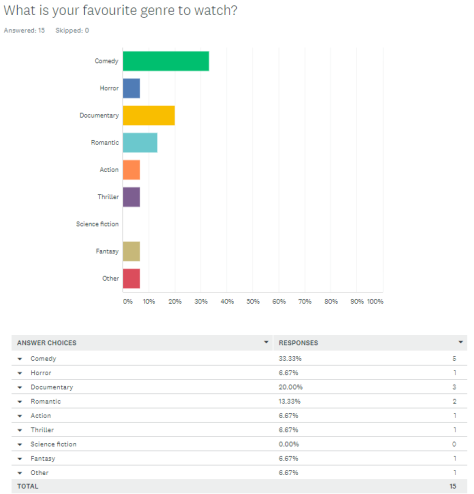
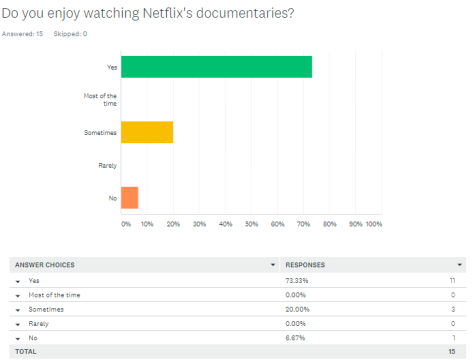
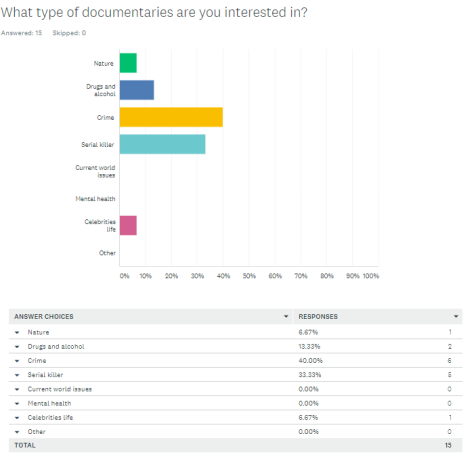
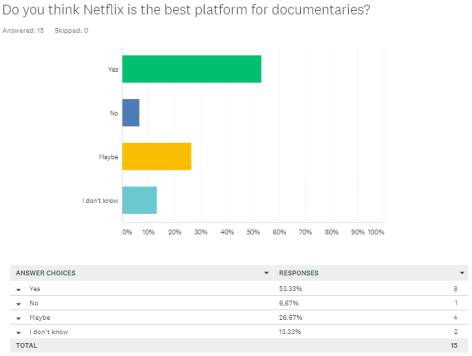
This survey has helped me understand Netflix’s target audience so now I can try and make my documentary fit. The target audience based from my survey are 15-24 year old females and this is very similar to the secondary target audience research i did, which also said that 15-24 year olds were their biggest audience.
Part Three- Develop documentary ideas:
Idea development:-
I have been struggling with thinking of a topic for my documentary so to help me think of one, I have decided to do a mind map. (Only a rough write down of notes)
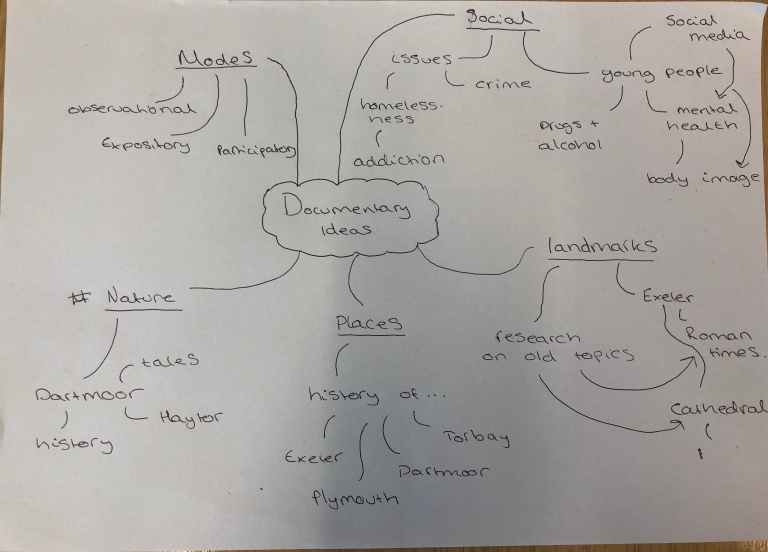
After doing my first mind-map, I decided that I was going to go down the route of social media and mental health within young people.
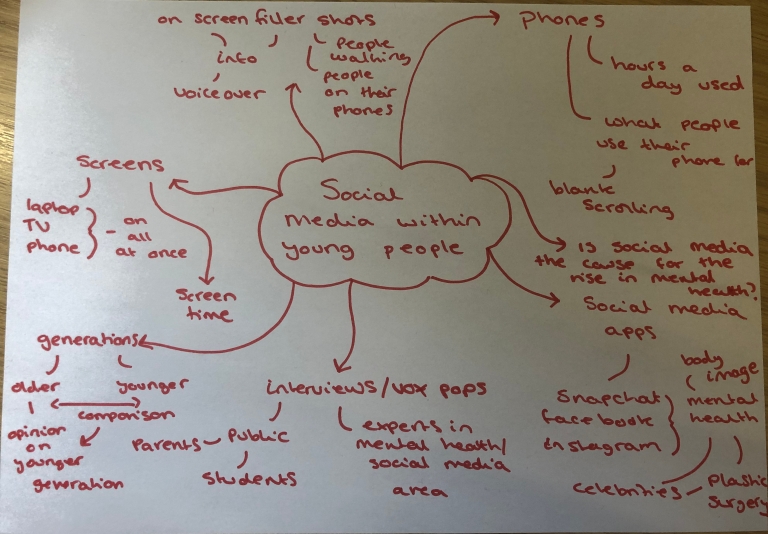
My idea proposal:-
The name of my documentary will simply be called ‘Social Media Documentary’. This will be about the pros and cons of social media and how it affects the younger generation. The mode of my documentary will be expository, this is because I plan to narrate in the background using a voice-over whilst filler shots are played. Netflix is my streaming service of choice as I watch Netflix documentaries a lot and feel like this particular documentary of mine would fit in and would interest their target audience.
The reason for choosing the social media subject is because I feel like it is very relevant in today’s society especially within young people. The use of technology and media is increasing as nearly everyone has a mobile phone or a type of social media such as Facebook, Instagram, Snap chat etc. I want to focus more on the disadvantages of social media on the younger generation as personally, I think that is more important to show. I will also add a lot of advantages as well to make it unbiased.
I chose Netflix as my streaming service because my documentary is targeted at the same audience according to my primary and secondary research. My target audience is both genders however I feel like it would attract more female attention and also aimed at young adults (15-30) as I believe that, younger people in today’s society would be more affected than the older generation.
Research into my topic- Social media within young people:-
Secondary research-
What is social media?:
Social media refers to websites and applications that are designed to allow people to share content quickly, efficiently, and in real-time. Many people define social media as apps on their smartphone or tablet.
Social media has dramatically changed the way we communicate, and there are a lot of benefits to it. We have access to unlimited information, we can connect with people from all over the world almost immediately and we can share with other things that matter to us. Social media is also a powerful tool in terms of motivating people to action and make social changes. It provides a platform for young people’s voices to be heard allowing them to have a say on issues that matter to them. The online world has the potential to help young people to explore new concepts, manage risks and build resilience.
However, because social media has evolved so quickly and has a deep impact on the social fibre and interpersonal relationships it’s important to explore the potential effects on young peoples’ emotional and mental health.
Social media apps: (popular with young people)
- Facebook/Messenger- Facebook is a website which allows users, who sign-up for free profiles, to connect with friends, work colleagues or people they don’t know, online. It allows users to share pictures, music, videos, and articles, as well as their own thoughts and opinions with however many people they like.
Facebook has over 1 billion users and once people are ‘friends’ on Facebook
the two profiles are connected with both users able to see whatever the other person posts. - Twitter- Twitter is an online news and social networking site where people communicate in short messages called tweets. Tweeting is posting short messages for anyone who follows you on Twitter, with the hope that your messages are useful and interesting to someone in your audience.Some people use Twitter to discover interesting people, celebrities and companies online, opting to follow their tweets.
- Instagram- Instagram is a free photo and video sharing app available on Apple iOS, Android and Windows Phone. People can upload photos or videos to our service and share them with their followers or with a select group of friends. They can also view, comment and like posts shared by their friends on Instagram. Anyone 13 and older can create an account by registering an email address and selecting a username.
- Snapchat- Snapchat is a mobile messaging application used to share photos, videos, text, and drawings. It’s free to download the app and free to send messages using it. It has become hugely popular in a very short space of time, especially with young people. There is one feature that makes Snapchat different from other forms of texting and photo sharing: the messages disappear from the recipient’s phone after a few seconds.
- WhatsApp- WhatsApp is free to download messenger app for smartphones. WhatsApp uses the internet to send messages, images, audio or video. The service is very similar to text messaging services, however, because WhatsApp uses the internet to send messages, the cost of using WhatsApp is significantly less than texting. You can also use WhatsApp on your desktop, simply go to the WhatsApp website and download it to Mac or Windows. It is popular with teenagers because of features like group chatting, voice messages and location sharing.
Pros and cons:
Pros-
- Connecting to other people all around the world- The use of social networking means that you can instantly reach people from anywhere. For example, Facebook to stay in touch with your old high school friends who’ve relocated all over the country or meet brand new people on Twitter from cities or regions you’ve never even heard of before.
- Easy and instant communication- As in this generation, most people have their smartphones on them at all times, we don’t have to rely on our landlines, answering machines or snail mail to contact somebody. We can simply open up our laptops or pick up our smartphones and immediately start communicating with anyone on platforms like Twitter or one of the many social messaging apps available.
- More informed about current affairs- With social media, teens can easily find out about what is going on in their neighborhood, school, state, country and even the entire world. It is one of the most common sources of information that students use. This information can be quite useful and enables them to make informed decisions based on what they know.
- Easier to study and carry out research- Social media platforms can act as a great study tool for students as they can ask other people difficult questions that they could not solve on their own. It also makes it easier for students in group discussions and study groups to learn and study together when they are far from each other. Students can also post research work on social media platforms to educate other students on a particular topic.
- General fun and enjoyment- A lot of people turn to social media when they catch a break at work or just want to relax at home. Since people are naturally social creatures, it’s often quite satisfying to see comments and likes show up on our own posts, and it’s convenient to be able to see exactly what our friends are up to without having to ask them directly.
Cons-
- Impact on sleep- Heavy usage can have a negative impact on physical well being which in turn can affect mental health. This is particularly relevant when it comes to sleep disturbance. Several studies have linked sleep difficulties to screen time. Whether it’s the blue light of screens affecting sleep quality and quantity or the behavioural disturbances that make young people wake to check their phones reduced sleep is an important issue when it comes to mental health. Sleep is crucial for the developing adolescent brain, and lack of sleep is associated with lower mood and depression.
- Social peer pressure and cyber bullying- For people struggling to fit in with their peers, especially teens and young adults, the pressure to do certain things or act a certain way can be even worse on social media than it is at school or any other offline setting. In some extreme cases, the overwhelming pressure to fit in with everyone posting on social media, getting the most amount of likes or becoming the target of a cyberbullying attack can lead to serious stress, anxiety and even depression.
- Distraction and procrastination- People get distracted by all the social apps and news and messages they receive, leading to all sorts of problems like distracted driving or lack of gaining someone’s full attention during a conversation. Browsing social media can also feed procrastination habits and become something people turn to in order to avoid studying, doing certain tasks or responsibilities.
- Destroys social skills- Due to the increased time that teens have spent interacting online and on social media; it affects the face to face communication and social skills of teenagers. You can find very outspoken kids on social media being quite reserved when it comes to face to face interactions.
- Leads to disclosing too much personal info- Social media has a way of making teens disclose a lot of information that they would not disclose face to face. By giving out too much information, for example about where one lives, where they go to school and other personal details. This can lead to problems such as potential harm to the teen.
Part Four- Making the documentary:
Pre-production:-
Production schedule-
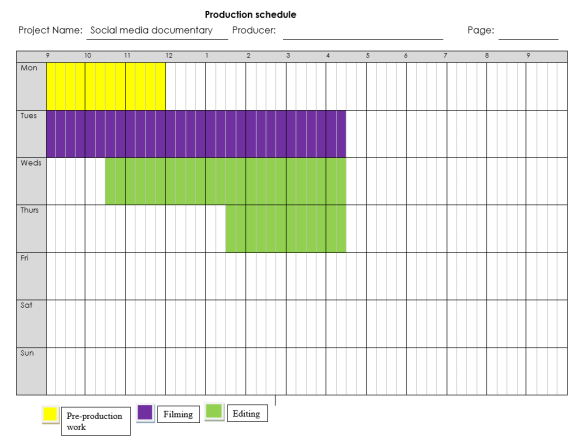
Shooting schedule-
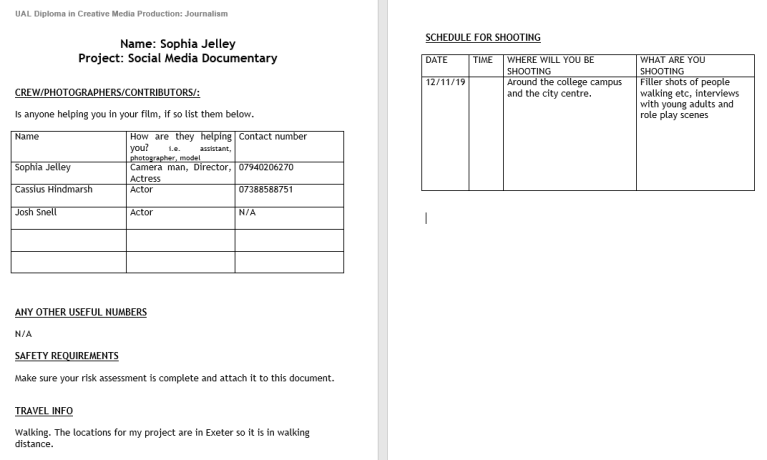
Risk assessment-
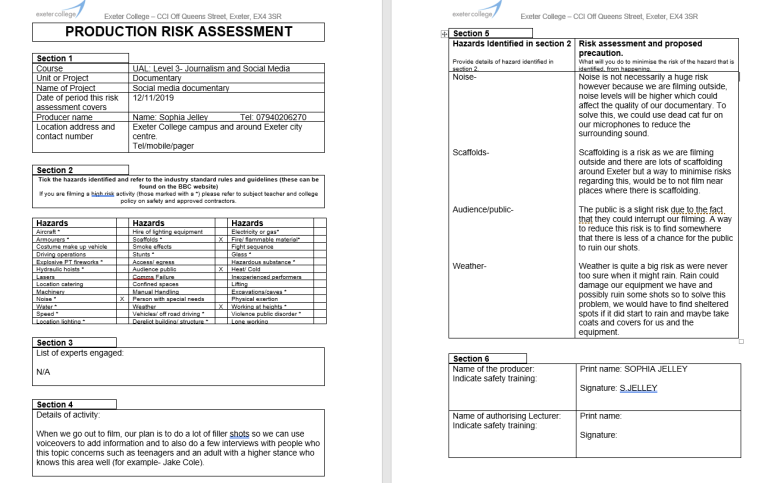
Consent forms-
My documentary:
Part Five- Reflecting on Success:
Audience Evaluation-
For this project, I aimed my documentary at at the younger generation (15-30) and also more towards the female population as due to my primary and secondary research, I found that females were more affected by this topic than males.
In my documentary, I included vox pops with young adults, filler shots with narrative in the background and scenes where acting is involved. I used young adults as my actors and as my interviewees because I thought that it would interest my target audience and they may be able to relate more knowing that these people are of the same age. I think that this worked well as both interviewees gave acceptable answers that genuinely concerns a lot of people in the younger generation.
When filler shots were played, I made sure to include factual and correct information that also met my target audience. I did this by recalling my secondary and primary research so that I knew it was reliable and accurate. I engaged with my target audience as I mentioned how social media affected the younger generation and certain genders throughout my whole documentary.
Overall, I feel that I did very well with making my documentary interesting for my target audience however, I could’ve improved by making more filler shots that were more interesting.
Overall Evaluation-
When I started this project, I wasn’t too sure on what I was going to do for it however after a lot of thinking and planning such as, mind maps and mood boards, I decided to do a documentary on social media. I chose this topic as I think that it is very relevant in today’s society because nearly everyone in the UK’s population has some sort of social media. I wanted to include the pros and cons of social media however include more cons as personally, I feel that there are more negatives than positives of it. I also wanted to make it about young people and how they are affected by it. This is because, younger people seem to be on social media more often and seem to be more affected by it than older adults.
To collect data and information for my documentary, I used primary research such as surveys and vox pops so that I could find out what the locals think about this situation and to gather their opinions. I then used secondary research to collect information that is reliable and accurate including quantitative data (statistics) and qualitative data (facts, opinions). In my opinion, the most important part of my research is all of my social media research especially the pros and cons and also finding out what each mode of documentary is helped me a lot. Lastly, my Netflix research was also really helpful as it gave me a clear insight on who my target audience should be.
Whilst making my documentary, I came across some problems such as having to work by myself and not being in a group last minute which made things a bit more difficult. I decided to carry on and film it by myself and with the help of my friends who are featured in the documentary. My role in the group was being the camera man, director, script writer, narrator, editor and actor, which was a lot to juggle but I was really proud of myself finishing it to a good standard.
Overall, I am very pleased with the outcome of my final project and my blog. I feel that I have really gone into detail with the theory aspect of this assignment and have succeeded my expectations with how good the final project was. Things that I will improve on for the future is my time management and making the filler shots more interesting to watch.

